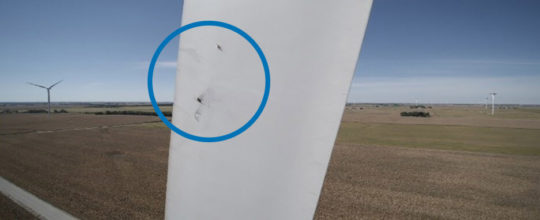When Lightning Strikes
Wind turbines are at increased risk of lightning strikes, and early damage detection is a crucial way to cut costs from lightning damage. Apex has addressed the issue with a new, proprietary system.
Managing lightning damage on wind farms has historically been both time consuming and costly. Site operators are often faced with the decision to perform a site-wide inspection after each storm or risk waiting until the end of lightning season to do a thorough inspection for lightning damage.
If an inspection is performed after every storm, site availability will suffer—personnel cannot address faulty turbines in a timely fashion, and costs increase if outside technicians are brought in. If inspections are postponed until the end of lightning season, damage to blades may have propagated by that time, and repair costs will rise significantly in turn.
To highlight the difficulty in this trade-off:
- Lightning often causes the joints between the blade shells to become separated. If a minor separation in the joint is caught quickly, then the repair can be done from a platform or ropes at a cost of $5,000 to $20,000. If the damage is not caught and the turbine goes on to operate, the joint will continue to separate, exponentially increasing the cost to repair it. There have been instances where the turbine shells separate completely; this is often referred to as a “banana-peel failure” and requires multiple cranes and extended turbine downtime. Costs in these cases can exceed $500,000.
- Many wind farms comprise hundreds of turbines, making a site-wide inspection to catch damages very costly to perform. This situation is intensified when the lightning season can potentially bring 20 to 30 days of lightning storms and even more lightning activity during the winter months.
ApexDetect

Sites managed by Apex’s Asset Management team are monitored by the internally developed lightning monitoring system ApexDetect. Every lightning strike within the borders of an Apex-operated wind farm is processed in real time to determine whether the lightning was within the likely strike zone for each turbine.
A database of likely lightning strikes to turbines—including the strike magnitude and direction—feeds automatic reports for site management following a storm, as well as an online tool that maps out the location of each relevant strike in relation to turbines at the site.
After a storm, site managers are able to do a targeted inspection of only the turbines that were struck by lightning. This ensures that lightning damage is caught and repaired immediately to minimize repair costs and avoids unnecessary inspections being performed.
In 2015, a turbine at an Apex-managed wind farm was struck by lightning. Using the ApexDetect tool and process, the damage was detected immediately after the strike. The lightning had caused visible but small damage to the blade shell. There was no auditory signature to the failure, so it is unlikely that the damage would have been detected without an inspection. And although the visible damage was small, the lightning had in fact caused internal structural damage to the blade. Immediate detection using ApexDetect and a timely repair prevented complete blade failure and a cost savings to the project of $300,000.
